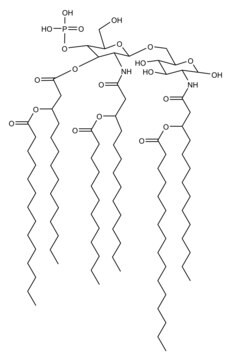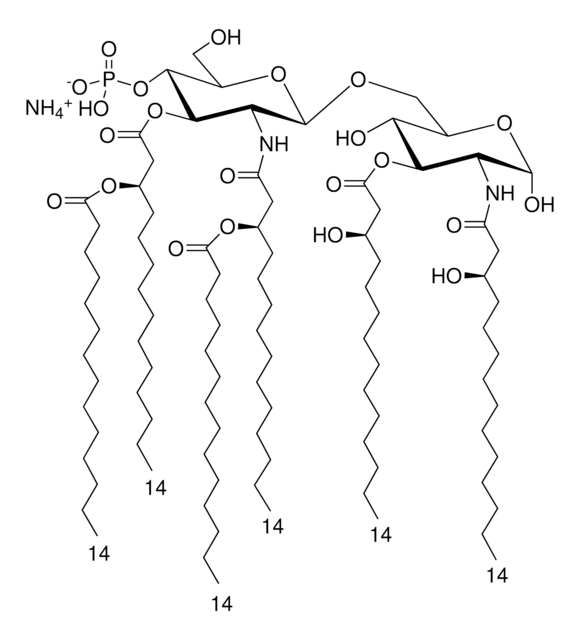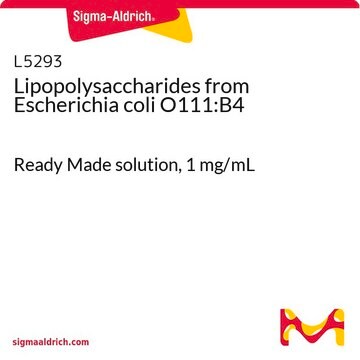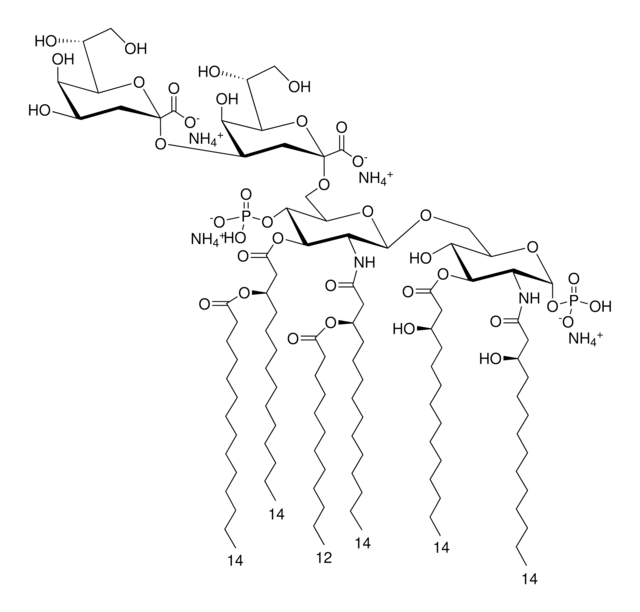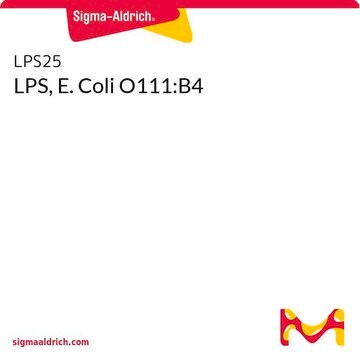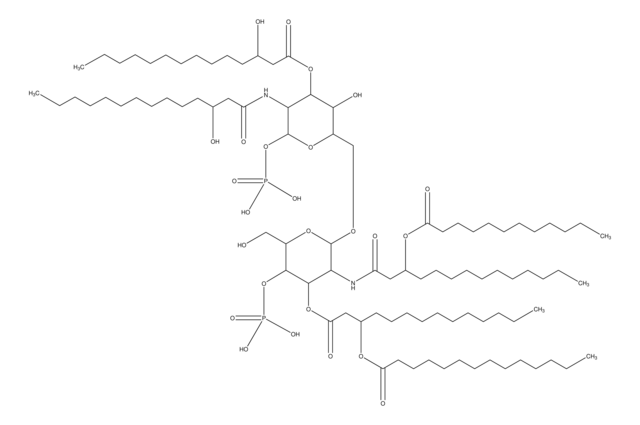추천 제품
생물학적 소스
Escherichia coli
분석
≥90% (HPLC)
양식
solid
저장 온도
−20°C
SMILES string
O=C(O)[C@@]1(O[C@H]2[C@@H](O)C([C@H](O)CO)O[C@](C(O)=O)(OC[C@H]3O[C@@H](OC[C@H]4O[C@H](OP(O)(O)=O)[C@@H](NC(C[C@@H](CCCCCCCCCCC)O)=O)C(OC(C[C@@H](CCCCCCCCCCC)O)=O)[C@H]4O)C(NC(C[C@@H](CCCCCCCCCCC)OC(CCCCCCCCCCC)=O)=O)[C@@H](OC(C[C@@H](CCCCCCCCCCC)OC(CCCCC
관련 카테고리
일반 설명
3-deoxy-D-manno-octulosonic acid (Kdo2-Lipid A) is the essential component of lipopolysaccharide in most Gram-negative bacteria and the minimal structural component to sustain bacterial viability. It serves as the active component of lipopolysaccharide to stimulate potent host immune responses through the complex of Toll-like-receptor 4 (TLR4) and myeloid differentiation protein 2 (MD2). Therefore, Kdo2-lipid A is an important stimulator for studying the mechanism of the innate immune system and for developing bacterial vaccine adjuvants. Kdo2 Lipid A/TLR4 antagonists can also be applied in anti-inflammatory interventions. Kdo2-lipid A, induces de novo sphingolipid biosynthesis in RAW264.7 macrophages, which is essential for induction of autophagy. Kdo2-Lipid A has been used in animal atherosclerosis model.
기타 정보
Solubility: Kdo2 -Lipid A can be dissolved in a solution of 0.1-0.5% Triethylamine (Sigma Cat# 90335) at 1 mg/ml (In case of percipitation use sonication). Use sonication to directly solublized in cell culture medium. Storage: Once Kdo2-lipidA is dissolved in 0.1-0.5% Triethylamine (Sigma Cat# 90335) aliquot and store at -20°C. The solution is stable for 2 months in -20°C.
Storage Class Code
11 - Combustible Solids
WGK
WGK 3
Flash Point (°F)
No data available
Flash Point (°C)
No data available
가장 최신 버전 중 하나를 선택하세요:
이미 열람한 고객
Kacee Sims et al.
The Journal of biological chemistry, 285(49), 38568-38579 (2010-09-30)
Activation of RAW264.7 cells with a lipopolysaccharide specific for the TLR4 receptor, Kdo(2)-lipid A (KLA), causes a large increase in cellular sphingolipids, from 1.5 to 2.6 × 10(9) molecules per cell in 24 h, based on the sum of subspecies
Philipp Wiesner et al.
Circulation research, 107(1), 56-65 (2010-05-22)
Oxidized low-density lipoprotein (LDL) is an important determinant of inflammation in atherosclerotic lesions. It has also been documented that certain chronic infectious diseases, such as periodontitis and chlamydial infection, exacerbate clinical manifestations of atherosclerosis. In addition, low-level but persistent metabolic
Nathanael J Spann et al.
Cell, 151(1), 138-152 (2012-10-02)
Inflammation and macrophage foam cells are characteristic features of atherosclerotic lesions, but the mechanisms linking cholesterol accumulation to inflammation and LXR-dependent response pathways are poorly understood. To investigate this relationship, we utilized lipidomic and transcriptomic methods to evaluate the effect
Christian R H Raetz et al.
Journal of lipid research, 47(5), 1097-1111 (2006-02-16)
The LIPID MAPS Consortium (www.lipidmaps.org) is developing comprehensive procedures for identifying all lipids of the macrophage, following activation by endotoxin. The goal is to quantify temporal and spatial changes in lipids that occur with cellular metabolism and to develop bioinformatic
자사의 과학자팀은 생명 과학, 재료 과학, 화학 합성, 크로마토그래피, 분석 및 기타 많은 영역을 포함한 모든 과학 분야에 경험이 있습니다..
고객지원팀으로 연락바랍니다.
